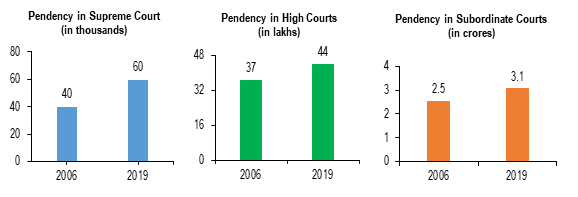Syllabus: GS2/Polity and Governance
Context
- The Supreme Court permitted High Courts to appoint retired judges on an ad-hoc basis to address the mounting backlog of cases.
About
- The Supreme Court first endorsed the appointment of ad-hoc judges in its 2021 ruling in Lok Prahari v. Union of India.
- These judges were authorised to hear only criminal appeals as part of a bench led by a sitting judge.
- Backlog: As of January 2025, High Courts were burdened with a staggering backlog of 62 lakh cases.

- In 2021, the SC noted there have only been three recorded instances of ad hoc judges being appointed under Article 224A, calling it a “dormant provision”.
Related Constitutional Provisions
- Article 224A of the Indian Constitution allows the Chief Justice of a High Court to request retired HC judges to perform the duties of a judge again, with the permission of the President of India.
- Such appointees are entitled to allowances as determined by the President’s order and have all the jurisdiction, powers and privileges of a Judge of that High Court.
- Lok Prahari v Union of India (2021): SC held that ad hoc judges can only be appointed when recommendations have not been made for less than 20% of the vacancies, after considering both the number of active judges and pending proposals for judge appointments.
Reasons for the Backlog of Cases in Indian Judiciary
- Insufficient Judges: India has one of the lowest judge-to-population ratios globally.
- Increased Litigation: The growing number of litigants and cases, coupled with the increasing population and socio-economic complexities, contributes to the rise in the number of cases.
- Delays in the Justice System: There are delays due to procedural inefficiencies, adjournments, and delays in filing of evidence, which further prolong case resolutions.
- Lack of Infrastructure: Many courts, especially in rural areas, are under-equipped and under-staffed, making it difficult to handle the growing number of cases efficiently.
- Bureaucratic and Administrative Challenges: The judicial process can sometimes be slowed down by inefficiencies in the system, including paperwork, administrative delays, and a lack of modernization in court processes.
How does it impact?
- Delay in Justice: The backlog results in long delays in cases, and justice is often delayed for years.
- Increased No. of Undertrials: The number of undertrials (accused awaiting trial) in prisons has increased, prisons are running at an over-capacity of 114%.
- Increased Costs: The delay in cases causes financial strain on the litigants and the government. It can also result in the erosion of public confidence in the judicial system.
- Overburdened Judges: Judges are often overburdened with cases, leading to burnout and further delays.
Efforts to Address the Issue
- Judicial Reforms: It includes increasing the number of judges, modernizing court infrastructure, and implementing e-courts and technology to speed up hearings.
- Alternate Dispute Resolution (ADR): ADR mechanisms like arbitration, mediation, and conciliation are being promoted to resolve disputes outside of the traditional court system.
- E-Courts and Technology: The E-Courts Project has been an important initiative to digitize court proceedings and allow online hearings. This helps in streamlining case management and reducing physical backlogs.
- Fast Track Courts: Special courts or fast-track courts have been set up to handle specific types of cases like corruption, crimes against women, and long-pending cases to expedite the process.
Source: TH
Previous article
News In Short 13-2-2025
Next article
Concerns Related To China’s Dam Project